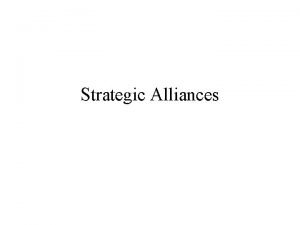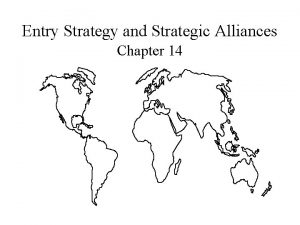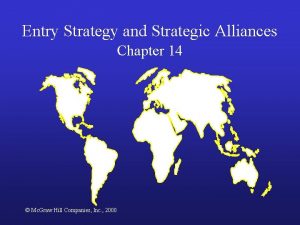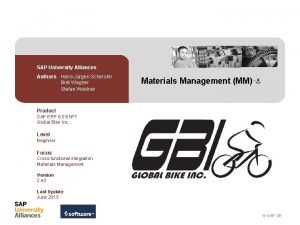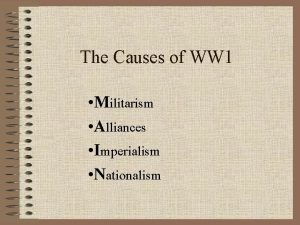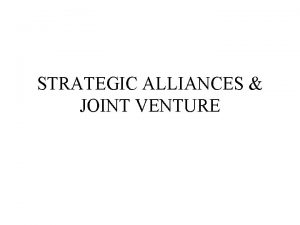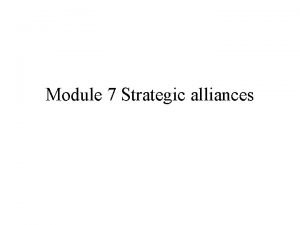Strategic Alliances Motivation for Strategic Alliances Technology Exchange






















- Slides: 22

Strategic Alliances

Motivation for Strategic Alliances • Technology Exchange • Global Competition • Industry Convergence • Economies of Scale and Reduction of Risk

Reasons for Strategic Alliances • • • Gain access to new markets Enter new businesses Introduce new products Overcome trade barriers Avoid predatory competition Gain access to complementary resources Pool resources, skills, and risk capital Share risk Share R & D expenses

Sources of Interfirm Synergies that can Motivate Strategic Alliances • • • Exploiting economies of scale Learning from competitors Managing risk and sharing costs Facilitating tacit collusion Low-cost entry into new markets Low-cost entry into new industries and new industry segments • Managing uncertainty

Entry Mode Exporting Licensing Advantages Disadvantages Ability to realize location and experience-curve economies High transport costs Low development costs and risks Lack of control over technology Trade barriers Problems with local marketing agents Inability to realize location and experience curve economies Inability to engage in global strategic coordination

Entry Mode Advantages Franchising Low development costs and risks Disadvantages Lack of control over quality Inability to engage in global strategic coordination Joint Ventures Access to local partner’s knowledge Lack of control over technology Sharing development costs and risks Inability to engage in global strategic coordination Political acceptability Inability to realize location and experience economies

Entry Mode Wholly owned subsidiaries Advantages Protection of technology Ability to engage in global strategic coordination Ability to realize location and experience economies Disadvantages High costs and risks

Motivation for International Strategic Alliance Formation To Take Existing Products to Foreign Markets New Markets Existing Markets Open Markets To Diversify Into a New Business Learning from your partner Closed Markets Learning with your partner To Strengthen The Existing Business To Bring Foreign Products To Local Markets Achieving economies of scale Marketing & distribution Acquiring technology “Screwdriver” assembly plants Developing local technology Reducing financial risk of Technology flowback to major core business projects foreign parent Existing Products New Products

PALs Across Companies • Pooling • Allying • Linking

Examples of Types of Strategic Alliances • Service Alliances • Opportunistic Alliances (Product-link) • Stakeholder Alliances

Contractual Forms • NONEQUITY ALLIANCE: managed through contracts • EQUITY ALLIANCE: Cooperative contracts & equity investments • JOINT VENTURE: Independent firm formed by cooperating firms

Threats as Opportunistic Behavior • Adverse Selection • Moral Hazard • Holdup

Integration Issues: Social Complexity • BARRIERS TO INTEGRATION – Different functional time orientation – Different functional language and interpersonal orientation – Different goal orientation – Formality of structure • FACILITATORS OF INTEGRATION – Shared values – New product vision provided by leadership – Budget allocation to foster integrated design

Strategic Alliances and Sustained Competitive Advantage • Rareness – Number of firms and other alliances in the industry(s) – Benefits obtained, especially complementary assets and abilities

Strategic Alliances and Sustained Competitive Advantage • Imitability – Direct Duplication • Difficulty in developing socially complex skills – Substitutes • Internal Development/Corporate Entrepreneurship – Venture Capitalists – New-Venture Incubator – Idea Generation and Transfer Program – Intrapreneurship

Strategic Alliances and Sustained Competitive Advantage • Acquisitions – Speed versus Cost of Acquisition – Access to Complementary Assets versus Unnecessary Adjunct Businesses – Removal of Potential Competitor versus Organizational Clashes – Upgrade Corporate Resources versus Major Commitment

Reasons for Acquisitions • • Increased market power Overcome entry barriers Increased speed Lower risk compared to developing new products • Increased diversification • Avoid competition

Strategic Fits Between a Target and a Bidder Business Adding New Related-Complementary Products Unrelated New Products Similar Customers New Products New Customers Identical Related-Supplementary Similar Products Similar Customers Similar Products New Customers Serving New Customers

Reasons For Acquisition’s Poor Performance • • • Overdiversification Managerial energy absorption Excess debt Too large Acquisition as a substitute for innovation May Lead to Need for Restructuring

Strategic Alliance Checklist 1. Understanding your capabilities and needs – Do you really need a partner? For how long? – How big is the payoff? How likely is success? – Is a joint venture the best option? 2. Choosing an appropriate partner – Does the partner share your objectives for the venture? – Does the partner have the necessary skills and resources? • Will you have access to them? – Will you be compatible? – Can you arrange an “engagement period? ”

Strategic Alliance Checklist 3. Designing the joint venture – Define the venture’s scope of activity, and its strategic freedom via its parents – Lay out each parent’s duties and payoffs, to create a “win-win” situation – Establish the managerial role of each partner 4. Doing the deal – How much paperwork is enough? Trust versus legal considerations – Agree on an end game

Strategic Alliance Checklist • Making the venture work – Give the venture continuing top management attention – Manage cultural differences – Watch out for inequities – Be flexible
 Global strategic alliance definition
Global strategic alliance definition Entry strategy and strategic alliances
Entry strategy and strategic alliances Equity strategic alliance example
Equity strategic alliance example Market entry modes for international businesses chapter 7
Market entry modes for international businesses chapter 7 Strategy
Strategy Addison currency exchange
Addison currency exchange Pearl exchange activity
Pearl exchange activity Gas exchange key events in gas exchange
Gas exchange key events in gas exchange Work, exchange and technology
Work, exchange and technology Work exchange and technology
Work exchange and technology The columbian exchange technology
The columbian exchange technology Fintec
Fintec Imperialism in 1900
Imperialism in 1900 Cost of world war 1
Cost of world war 1 Types of functional alliances
Types of functional alliances Doctrines et alliances
Doctrines et alliances Wwi allies
Wwi allies Picture of alliances
Picture of alliances Esco
Esco Sap material master data
Sap material master data Wwi alliances political cartoon
Wwi alliances political cartoon Militarism alliances imperialism nationalism
Militarism alliances imperialism nationalism Alliances and acquisitions
Alliances and acquisitions
